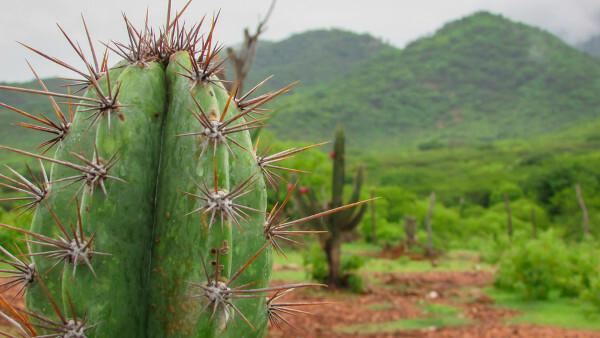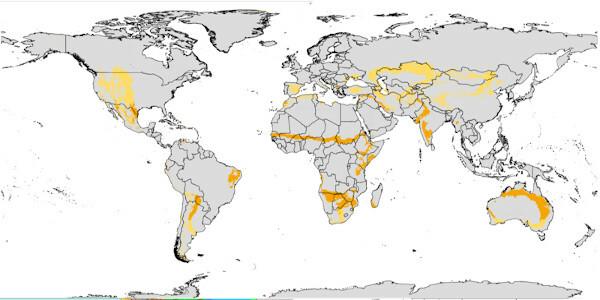THE semi-arid climate occurs in areas of high pressure, between the 20º and 30º parallels, in both hemispheres. It is characterized by high temperatures, low annual thermal amplitude and scarce and poorly distributed rainfall, with long periods of drought. The main forms of vegetation found in the semi-arid areas are savannas and steppes. In Brazil, this climate comprises the interior of the Northeast region and the north of Minas Gerais.
Read too: Climates in Brazil — the types of climate present in the Brazilian territory
Topics of this article
- 1 - Summary on semi-arid climate
-
2 - Characteristics of the semi-arid climate
- semiarid temperature
- semiarid vegetation
- 3 - Semi-arid climate in Brazil
- 4 - Semi-arid climate in the world
- 5 - Environmental, economic and social problems of the semi-arid climate
- 6 - Exercises solved on the semi-arid climate
Summary of semi-arid climate
It occurs predominantly between latitudes 20º and 30º, N and S.
It is characterized by high temperatures, low annual thermal amplitude, low relative humidity and long periods without rain (drought).
Its characteristic vegetation is that of steppe and savannah, with the presence of plants adapted to periods of drought.
In Brazil, it predominates in the interior of the Northeast region and in the north of Minas Gerais. The characteristic biome is the Caatinga, with some small areas of Cerrado.
The lack of rain and intense heat in areas with a semi-arid climate cause several socioeconomic problems, intensifying those already present, such as hunger and poverty. As for environmental problems, the main one currently is desertification.
Do not stop now... There's more after the ad ;)
Features of the semi-arid climate
The semi-arid climate is one of the variations of tropical weather, and for this reason it is also called tropical semiarid. This climate is present in the Tropical Zone of the planet Earth, being characteristic of areas of high pressure located in mid-latitudes, between 20º and 30º, both in the Northern Hemisphere and in the South.
The main aspect of this climate is the low relative humidity of the air and the irregular rainfall regime, with the existence of long periods of drought, that is, with the complete absence of rains. Annually, the accumulated volume of rainfall is at least 250 mm|1|, with maxims that depend on the locality.
In Brazil, for example, annual rainfall can reach 750 mm. Drought directly influences the landscape composition of the semiarid areas, in addition to affecting agricultural productivity and the lives of people living in these regions.
It is registered, in some areas of semi-arid climate, the occurrence of intense and concentrated rains in a short period.
semiarid temperature
Being a tropical climate, the semi-arid is characterized by high temperatures. However, it is noteworthy that maximum temperatures are comparatively lower than those found in arid climate areas such as deserts.
THE thermal amplitude the semiarid region is low, which means that there is little variation in temperatures during the year, with averages of approximately 27 ºC. With that, the summers are very hot and the winter months are a little milder, but still have high temperatures. The maximum is around 28 ºC and can, in some regions, exceed 30 ºC, while the minimum is not lower than 20 ºC.
semiarid vegetation

As a result of prolonged droughts and high temperatures, added to the soils stony and low fertility, the vegetation of the semi-arid climate is quite sparse and of low and medium stature (up to approximately 12 meters), with the predominance of species of grasses, shrubs and trees with thick bark, twisted trunk and evergreens, that is, they lose their leaves during the dry season.
Others defense mechanisms and adaptation to low humidity (which are called xeromorphism) that the flora of semi-arid climates have are:
presence of thorns;
ability to accumulate water inside, like cacti;
a layer of wax over the leaves, which prevents them from drying out;
superficial roots, which spread in the vicinity of the plant so that rainwater can be absorbed, and, in some places, species with deep roots, which absorb water and nutrients that may be in the soil, such as the juazeiro, present in the semiarid region Brazilian.
Formations such as the steppes and the sadvance, which, in Brazil, receives the name of Caatinga in the regions of occurrence of this specific climatic type.
Read too: Caatinga — the uniquely Brazilian biome
Semi-arid climate in Brazil
The semi-arid climate occurs in Brazil predominantly nthe inside ofnortheast region, covering part of the territories of all nine states that comprise it, and also in the northern portion of the state of Minas Gerais. The area covered by the semi-arid region in the country is equivalent to 12% of the national territory, totaling 1262 municipalities, where 28 million inhabitants live.|2|
The main characteristics of this climate in Brazil are the long periods of drought and the rains concentrated in a short period, between the months of November and April. In total, annual rainfall varies from 250 mm to 750 mm. In these regions, the presence of Caatinga and some areas of Çwrong, which characterize the Brazilian savanna.
Although it is more common for the period without rain to last a few months, in the history of very recent records of droughts that lasted years old. The most recent lasted from 2012 to 2017, a period in which there was very little rain, well below average |3|, causing severe damage to the population and also to the fauna and flora of the Brazilian semiarid region. The drought risk in this region is currently 60%.|4|
Semi-arid climate in the world
the semi-arid climate occurs in almost every continents, between latitudes 20º and 30º, North and South. As shown in the map below, this climate is present in the following locations:
southern Canada, western United States and part of Mexico;
Northeast Brazil, and part of Bolivia, Paraguay, Argentina, Venezuela and Ecuador;
extreme north of Africa, central strip of the African continent, immediately south of the Sahara desert, and part of southern Africa;
Spain, Russia, Turkey and Ukraine;
Middle East and Central Asia;
eastern and western regions of Australia.

Environmental, economic and social problems of the semi-arid climate
Droughts, intense heat and low quality soils that characterize the areas covered by the semi-arid climate are factors that condition serious socioeconomic problems, in addition to aggravating those that already exist and that are historically perpetuated.
The population that inhabits these regions has major limitation on the development of agricultural crops and the practice of livestock, which is due to the lack of rain, therefore, scarcity of water resources, and the conditions of the soil, causing problems such as hunger and poverty. With few sources of drinking water and rivers mostly intermittent, the thirst appears in many of these areas. The strong heat is still an aggravating factor that drastically reduces their quality of life.
Among the solutions found by the population, there are seasonal migrations and also the rural exodus, of a more definitive character, moving to areas that offer better climatic and economic conditions.
As for the environmental problems, today the main one that threatens areas of at least 100 countries, one of them the interior of the Brazilian Northeast, is the phenomenon of desertification. It is the physical-chemical degradation of the soil, which leads to its depletion and the impossibility of future use, if recovery measures are not applied in time.
Check it out on our podcast: Poverty in Brazil and in the world
Solved exercises on the semi-arid climate
question 1
(Uece) Tick the INCORRECT statement about the Brazilian semiarid region.
a) From the geo-environmental point of view, in addition to climate vulnerabilities, a large part of the soil is degraded.
b) The processes of land use have induced the degradation of soils, biodiversity and the loss of productivity of traditional agriculture.
c) The availability of water is no longer a critical factor, since, with the construction of large dams, the population and the activities they practice are fully served.
d) The most important limiting factor for human and animal life and for agricultural production activities is the scarcity of water resources.
Resolution
Alternative C. Although major engineering works have been installed in the Brazilian semi-arid region with the aim of bringing water to the most susceptible population to the effects of droughts and thus guarantee their water security, many of them have not yet been completed or do not meet their target Audience.
question 2
(UEPB) Observe the rainfall below. In them, the rainfall indices are represented by the columns, while the temperature variation is represented by the line. Based on the reading of the graphs, identify the respective descriptions made of them.

( ) Semi-arid climate with summer and autumn rains. It has low rainfall and low thermal amplitude with high temperatures throughout the year.
( ) Subtropical climate, with well-distributed rainfall throughout the year and high thermal amplitude, with hot summers and cold winters.
( ) Equatorial climate, with abundant rainfall and high temperatures throughout the year, with no dry season.
( ) Coastal tropical climate under the influence of the trade winds, with abundant rainfall in winter, a season in which high temperatures decline.
The alternative with the correct sequence is:
a) 4-3-2-1
b) 3-4-2-1
c) 3-1-2-4
d) 3-4-1-2
e) 1-2-4-3
Resolution: alternative D. The semi-arid climate is represented by the climogram number 3, which shows scarce and concentrated rainfall, in addition to high temperatures. The climate that has well-distributed rainfall and high thermal amplitude is subtropical, represented by graph 4. The following climates equatorial and coastal, are characterized in climograms 1 and 2 respectively.
Grades
|1| AYOADE, J. THE. Introduction to çlimatology for the tropics. Rio de Janeiro: Bertrand Brazil, 1996. 332 p. 4th ed. Translation by Maria Juraci Zani dos Santos.
|2| and |4| MINISTRY OF SCIENCES, TECHNOLOGIES AND INNOVATIONS. Instituto Nacional do Semiárido: the Brazilian semi-arid region. Available on here. Access on 25 Sep. 2021.
|3| REBELLO, Aiuri. The 2012-2017 drought in the semiarid region was the longest in Brazilian history. UOL Notícias, 03 Mar. 2018. Available on here. Access on 25 Sep. 2021.
image credits
[1] Wikimedia Commons (playback) [On the map, the title has been deleted Semi-arid, steppe (BS).]
By Paloma Guitarrara
Geography teacher


